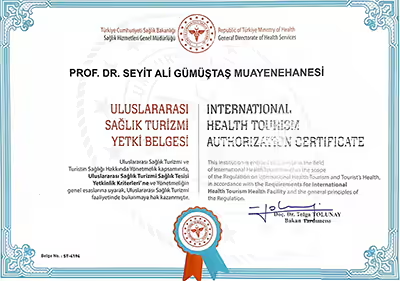RISKS AFTER BONE AND SOFT TISSUE SURGERIES
- Hits: 525
As with any surgery, there are risks associated with bone and soft tissue tumor surgery. These risks can be roughly divided into two categories: general and surgery specific. First, it is best to have an anesthesiologist explain the risks associated with anesthesia.
1. Problems at the wound site
Among the general risks associated with the surgery to be performed, we must first mention the risks associated with the wound. These are mainly wound infection, necrosis (gangrene) and wound dehiscence. Wound infection and discharge are rare risks, while gangrene and dehiscence are much rarer risks. The incidence of wound site problems depends on the size of the wound, the duration of the surgery, the space left after the tumor is removed, the general condition of the patient, whether the patient has had previous surgery in the same area, whether the patient has had chemotherapy and especially radiation therapy in the same area.
Wound infections can be superficial or deep. Superficial infections can usually be treated with oral antibiotics. Deep infections may require intravenous or intramuscular antibiotic treatment specific to the microbe grown in the culture taken from the wound. In cases where antibiotic treatment is not sufficient, repeated debridement (cleaning) may be used. Especially in resistant infections involving implants (nails, plates, screws, etc.) and prostheses, the existing implant or prosthesis may need to be removed. We can increase the local treatment effect by applying antibiotic cement to the resulting cavity. In case of bone infection (osteomyelitis), it will be necessary to apply antibiotic treatment for at least 6 weeks, 3 weeks intravenously and 3 weeks orally.
Gangrene or dehiscence at the wound site is most common in patients with large wounds, prolonged surgery, and especially in patients who have undergone radiation therapy and have a large cavity after tumor removal. In these patients, after the necrotic part (gangrene) is surgically removed, we can use repeated cleansing procedures and negative pressure closure devices, which we call VAC for short. We can get assistance from the microsurgery team (hand surgeons or plastic surgeons) to close the open wound.
Another wound site problem is the scar tissue that develops at the wound site and the healing scar we call keloid. This situation usually develops as a result of the body’s overreaction to wound healing. We recommend that patients use special creams to minimize this situation as much as possible. We also ensure that there is as little scarring as possible by using aesthetic sutures.
Finally, numbness, tingling, and numbness may develop around the wound. The nerves that provide sensation to the skin are arranged like a spider’s web in the skin. When we make an incision for surgery, this condition develops because the connections in this nerve network are cut.This condition can last up to two years. Sensation around the wound may not completely return to normal.

2. Recurrence of tumor
Unfortunately, both soft tissue and bone tumors have a certain risk of recurrence. The risk of recurrence depends mainly on the type of tumor and the success of the surgery, but even the most ideal treatment cannot completely eliminate this risk. Even after the simplest lipoma surgery, the risk of recurrence is very low. However, this risk is much higher for locally aggressive bone tumors (giant cell tumor of bone, aneurysmal bone cyst, osteoblastoma, and chondroblastoma) and soft tissue tumors (desmoid tumor and diffuse tenosynovial tendon tumor).The risk is nearly 100%, especially for malignant bone (giant cell tumor of bone, aneurysmal bone cyst, osteoblastoma and chondroblastoma) and soft tissue (desmoid tumor and diffuse tenosynovial tendon tumor) tumors where the tumor cannot be removed cleanly. In order to minimize the risk of tumor recurrence, it is our duty to provide the best possible treatment. It is important that these treatments be performed by an orthopedic surgeon who specializes in bone and soft tissue tumor surgery. To reduce this risk, we remove the tumor in one piece for benign soft tissue tumors. For some benign bone tumors (giant cell tumor, aneurysmal bone cyst, osteoblastoma, and chondroblastoma), we perform what is called aggressive curettage (cautery, burr, femol, alcohol, liquid nitrogen, hydrogen peroxide, etc.) in addition to scraping the tumor. In malignant bone and soft tissue tumors, the indispensable rule regarding the risk of tumor recurrence is to remove the tumor with clean margins (wide resection). For malignant soft tissue tumors, we use radiotherapy before or after surgery to reduce this risk. Depending on the type of malignant bone tumor, we may use chemotherapy or radiotherapy in addition to surgical treatment.
Because of the risk of recurrence, we follow our patients for many years at regular intervals. For patients who develop a recurrence during follow-up, we make a new treatment plan based on the type of tumor and follow-up radiological images.
3. Failure to completely remove the tumor with clean margins
This can happen especially with malignant bone and soft tissue tumors. During surgery, we aim to remove the malignant tumor with clean margins and plan accordingly. However, if the pathological examination of the removed tumor shows microscopically that there are areas adjacent to the tumor in the surgical margins, we may need to plan a reoperation (bed resection) to remove the residual tumor.
4. Vascular, nerve or internal organ injury
This risk is particularly high for large malignant tumors adjacent to major vessels, nerves, or internal organs. We call these cases "knife-edge". On the one hand, we do not want to penetrate the tumor, and on the other hand, we do not want to damage these structures. Even if there is no direct injury, numbness, tingling and temporary or permanent paralysis may occur due to the associated nerve due to contact during surgery. Similarly, an intravascular clot called a thrombus may develop in the major vessels. We routinely give blood thinners to appropriate patients to prevent this clotting. This risk of clotting can develop due to immobility even when there is no vascular contact. Sometimes the tumor may be attached to these structures or even more, these structures may be surrounded by the tumor. In this case, we perform the operation together with the relevant specialists (cardiovascular surgery, general surgery, spine surgery, urology, etc.). It may be necessary to remove a major vessel, nerve, or part of an internal organ along with the tumor. We perform a vascular graft, called a bypass, for the main vessels that have been removed. We perform a nerve graft (we usually use the sural nerve for this purpose) instead of the main nerve that we remove. In case of internal organ injury, the repair is performed by the appropriate specialist, and in case of removal, the necessary surgical procedure is performed (e.g. opening of colostomy in case of rectum removal).
5. Calcification, limitation of movement and loss of strength in the joint
Depending on the extent of the surgery, especially intra-articular and peri-articular surgery may result in calcification of the joint and loss of motion. In addition, especially in malignant tumor surgery, we have to remove some of the surrounding muscles along with the tumor (wide resection), which can also lead to loss of strength. To minimize this risk, we try to preserve the articular cartilage as much as possible and start with bed exercises immediately after surgery. We are supported in this by physical therapy, especially after the wound has healed.
6. Pain
We expect the pain to decrease day by day, especially in the first few days after surgery. This pain usually disappears after the wound has healed (two weeks on average). However, it may last longer depending on the surgery performed. We can overcome this problem with medication.
7. Differences in the final pathology result with biopsy and the need for additional treatment.
We see this situation very, very rarely. Sometimes the samples taken during biopsy turn out to be benign and the samples taken during surgery turn out to be malignant. In this case, we may need to perform additional surgery, chemotherapy and/or radiotherapy, depending on the type of tumor. To minimize this risk, we refer biopsy samples to our trusted pathologists who specialize in bone and soft tissue pathology.
8. Problems associated with reconstruction
The cavity formed after tumor removal is reconstructed using various methods. These may be biological (bone graft, vascularized fibula, etc.) or non-biological (bone cement, tumor prosthesis, etc.). Potential risks include non-union and fracture development with biological methods and prosthesis loosening and fracture development with non-biological methods.
9. Length difference and deformity
This is a risk we may encounter with tumors that involve the growth plate in the bone, especially in children whose growth is incomplete. In benign tumors, this may occur because the growth plate may be partially damaged when the tumor is scraped. In malignant tumors, if the growth plate has to be removed along with the tumor, the shortness occurs because the bone cannot grow from that area. In order to reduce the length difference and equalize the length of the arm or leg, we can perform lengthening on the short side and temporary or permanent freezing (epiphysiodesis) of the growth plate on the long side. We can perform corrective surgery (osteotomy, etc.) in case of deformity.
10. Deep vein thrombosis (development of a clot in the veins) and/or embolism (clot traveling to vital organs such as the brain or lungs)
The risk is particularly high in patients with comorbidities (heart failure, vascular disease, trauma, history of cancer, sedentary lifestyle, smoking). In order to minimize this risk, we prescribe appropriate blood thinners during hospitalization (in some patients, we ensure that they continue to take blood thinners after discharge), we use compression stockings, we may use pneumatic devices, and we walk our patients by starting exercise as early as possible. For very high-risk patients, we can refer patients to interventional radiology before surgery and place a vena cava filter.
11. Requirement for additional surgery
This situation may occur for any of the reasons listed above. Wound problems, tumor recurrence, different final pathology results, injury to vessels, nerves or internal organs, reconstruction problems, length difference or deformity and limitation of movement may lead to the need for reoperation.
12. Loss of an extremity (arm or leg)
This is a situation we do not want at all. Especially in the case of malignant tumors (bone or soft tissue cancer), it may be necessary to perform amputation (removal of the arm or leg at the appropriate site) as a last step in case of tumor recurrence, tumor involvement of all tissues including major vessels and nerves, wounds or infections that do not heal despite appropriate treatment, especially if the patient’s general condition is impaired or if chemotherapy treatment is interrupted and the patient’s life is at risk.
Note: Before the procedure, the patient and accompanying family members are informed of the possible risks in an understandable language and written consent is obtained.
Our goal is not to frighten or upset patients or their families by telling them about potential risks, but to raise awareness.
We do not want any of these risks to occur, but if they do, we will meticulously perform all necessary treatments to resolve the existing problem in the best way poss

